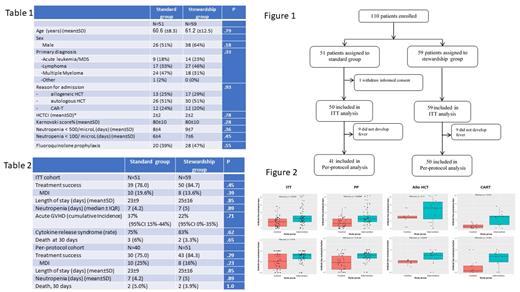Abstract
Background: Neutropenic fever is a life-threatening condition which is common in patients undergoing allogeneic/autologous hematopoietic cell transplantation (HCT) or chimeric antigen receptor - T cell (CAR-T) therapy. Empirical treatment includes monotherapy with a beta-lactam containing anti-pseudomonal activity. Nevertheless, stewardship of antibiotic in this vulnerable population is controversial.
Methods: This was a single center, prospective, unblinded randomized study, of patients after HCT or CAR-T therapy that were enrolled between January 2020 and March 2021. Allocation was concealed in sequentially numbered sealed opaque envelopes. All patients signed informed consent and the study was approved by the Tel Aviv Medical Center Institutional Review Board. Patients were randomly assigned to receive either standard empiric antibiotic ( piperacillin/tazobactam or ceftazidime) that was continued until recovery of counts (control group), or standard empiric antibiotic that was discontinued after 48-72 hours providing there was no evidence of clinical or microbiology documented infection (intervention group). Rapid identification of bloodstream infections was performed with BioFire filmarray multiplex PCR assay (bioMerieux), and results were used to adjust antibiotic treatment early. The primary outcome was the percentage of days without empiric antibiotic (antibiotic-free-neutropenia days). Secondary outcome included successful response to treatment, defined as the combination of- continuation of clinical improvement on day 5 after initiation of antibiotic, no reoccurrence of bacetermia/fever/clinical infection signs on day 5, and no need for additional therapy on day 4-5 after starting antibiotic. Breakthrough fever, death within 30 days of episode onset, duration of hospitalization, duration of neutropenia, graft vs. host disease (GVHD) and characteristics of cytokine release syndrome (CRS) were also evaluated, as appropriate.
Results: 110 patients were randomized to standard therapy (control group, n=51) and antibiotic stewardship strategy (intervention group, n=59), Figure 1. The patients' baseline characteristics were well-balanced between the 2 groups, Table 1. Febrile neutropenia occurred in 91 of the patients, and these patients were eligible for the per-protocol analysis. In the intention-to-treat population, the fraction of antibiotic-free neutropenia days was significantly higher for patients allocated to the stewardship arm, compared to those allocated to the standard arm (median [IQR], 0.8 [0.62-0.86] versus 0.51 [0.17-0.86], respectively, p=.0016). This was also true for the subgroups of patients treated per-protocol (median [IQR], 0.75 [0.61-0.83] versus 0.42 [0.12-0.72], respectively, p<.001) and in the subgroups of patients after allogeneic HCT, autologous HCT and CAR-T therapy (0.75 [0.57-0.86] vs. 0.5 [0.40-0.51], p=.0046; 0.66 [0.62-0.83] vs. 0.59 [0.19-0.81], p=.077; and 0.7 [0.45-0.82] vs 0.06 [0-0.28], p=.025, respectively), Figure 2. There was no difference in the success rate between the 2 groups (84.7% vs. 78%, P =0.45). Thirty-day death rate was similarly low in both groups. Other outcome are depicted in Table 2. Linear regression was used to assess the interaction of patient and treatment variables with the fraction of antibiotic-free days. Assignment to the stewardship arm was significantly associated with a higher fraction of antibiotic-free days (p=.003), whereas CART treatment was associated with a lower fraction of antibiotic-free days (p=.004).
Conclusions: This is the first randomized study showing in a homogenous population of patients after cellular therapy, the safety of antibiotic stewardship. Optimization of antibiotic schedule is a widely available and cost-effective strategy to improve treatment outcomes in patients with high risk febrile neutropenia after cellular therapy.
Ram: Gilead: Honoraria; Novartis: Honoraria. Avivi: Kite, a Gilead Company: Speakers Bureau; Novartis: Speakers Bureau.


